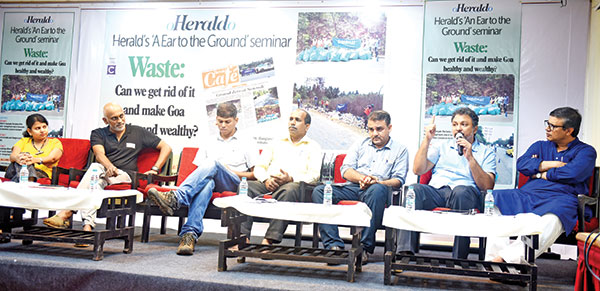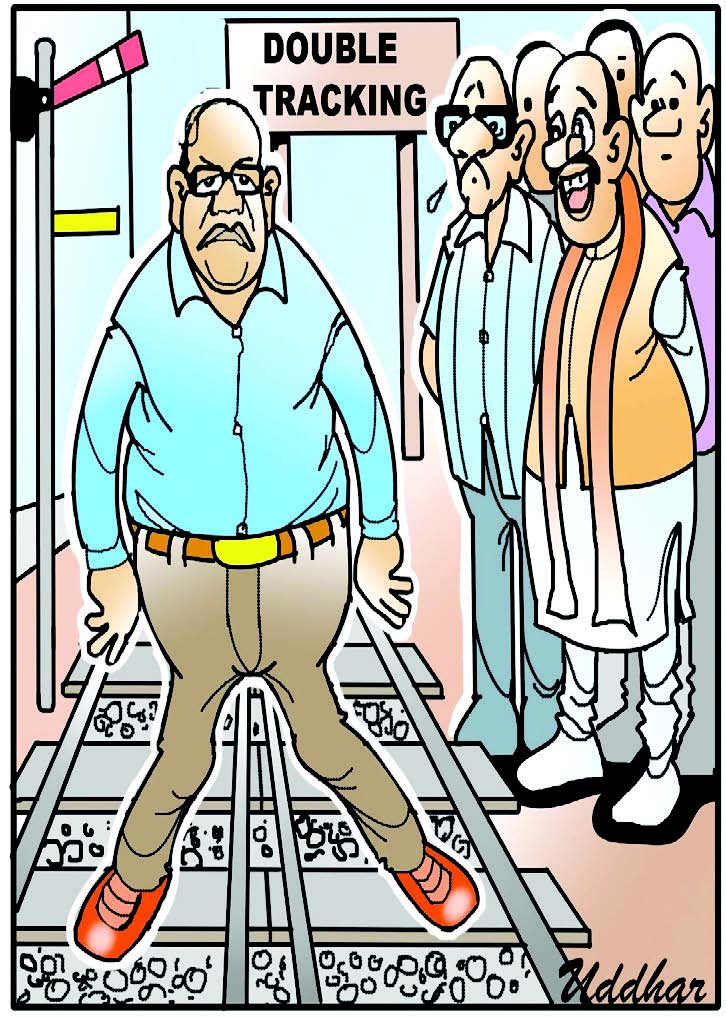25 Aug 2019 | 05:58am IST
‘How garbage affects tourism: Efforts of the tourism department to control waste management in the coastal belt’
The moderator Sujay Gupta said Goa had the boon as well as the bane of tourism. With so many footfalls coming in,they leave behind much waste and this was a problem which needed to be tackled by Goa stake holders. Goa was getting a bad name because of garbage. We have to be more responsible as well as make the tourists more responsible.
Responsible Tourism and the kind of messaging required Maria Victor: “Goa has promoted itself as a party destination, sun and beer and sand and that lead to all the irresponsible practices. There are people drinking by the beaches, throwing beer bottles. There is a policy but the enforcement of the policy is something else. There is a responsible tourism collective of ten entrepreneurs who are bringing in a fresh innovative approach. Here you have people saying Goa is not only about fun, beer and the sand but there is much in the biodiversity and the cultural side which has to be respected. This has to be done in a manner mixed with humour because people are coming here to relax. If you tell tourists to clean the beach, they will tell you they have just landed but if you create a beach walk the they will respect the beach more. You have local involvement where they serve an authentic Goan meal, which does not involve a lot of litter. So, you are giving a tourism experience. If we offer it, I don’t see why they will not take it and if it done in a sustainable way they will take it. It is also up to the tourism stake holders to offer more sustainable offerings. So then, at the hotels, no bottled water but ‘RO’ water. If someone still wants bottled water, charge a premium so you are not encouraged to buy bottled water. Every hotel serves two bottles of water and that can be replaced with RO water. It depends on the kind of experience we curate that will reduce waste.”
The moderator said it was important to also talk about responsible tourists. There were large numbers visiting the state and a substantial number were irresponsible. They come and litter. Tourists from Maharashtra and Karnataka who would not do it in Mumbai and Bengaluru take it as a given that they can litter in Baga or Panjim. Should we have some deterrent against these tourists?
Richard Dias said he would prefer to look at this through a different lens. He said whenever the domestic tourist, the migrant worker and others are blamed, there were three fingers pointing back. The tourists, he said were learning from you and I, the residents of the state. “They pick up from the way we behave in our cities. Not everyone was like that but a large number were uncaring only interested in our businesses. Responsibility is with us, he emphasized, adding that it was important to re-educate oneself. In time tourists will change too.
Clinton Vaz felt the problem was due to both the sides being at fault. “If a Goan is caught dumping garbage on the road they get very arrogant and will fight back and its puts you in an awkward situation and once it even went to the police station. The police were not keen on apprehending the guy. He also pointed to what happens on the other side and elaborated how they manage waste at domestic housing societies and that there is a difference in the waste from inside Goa and coastal Goa. “You train the Goans living in the hinterlands in housing complexes; once you train them they give you sorted waste. But when you go to the coastal side, the apartments are generally rented to people who come for two or three days and he is there to have a good time and garbage segregation is the last thing on his mind. He makes a mess and leaves and we don’t know who to catch at that point. We have this sticker which we leave behind stuck on the bin if the garbage is mixed. If the person has left this sticker has no meaning. I am a contractor in that situation and I can request someone to segregate but I cannot enforce it because I am not the law. If I go to the law it is a 3 or 4 month process for action to be initiated and by then nothing really happens,” he added.
Amitava Bhattacharya said he did not agree with the notion that tourist training was important and that any place would have to depend on a certain kind of tourist to stay in business. He said it was important to not forget the Goa University campus incident. He said he was from Kolkata but had been visiting Goa since 2004-05 and he had been seeing it from up close and could see the vulnerability of women and children from tourism and people were in denial. “It is important to take responsibility and in responsible tourism there is a very important part that is whatever is good for community is good for tourism. That is the basic definition and one does not have to be touristic to attract tourism. Too much of glossiness, that has to be reversed, cultural tourism of which no effort was made but recently some initiatives have started. It is still very small. That why I will be harsh and say that Goa has lost the traditional art and culture. If it has to be revived then one will have to invest in people,” he added. The outfits one generally sees during carnival day he said were commercial outfits and too much of competition does not save an art form. “This would then mean the next generation had not taken it up. Goa was the repository of handicrafts, its bamboo work was phenomenal but lack of recognition, lack of encouragement has led to a group of people to leave that. If that cultural transfer of information had taken place through the generations it would have benefitted tourism. It would have been in the villages and then the response to tourism would be different. I hope that is resumed because it would be helpful,” he added. He further cited the example of Cox Bazar in Bangladesh where he was having tea in a container and the person who served him waited to take the container back. Talking of Indian tourism, he said we have gone about it the wrong way. He presented the example of Sunderbans, the largest Delta in the country and it was always represented in advertising by a tiger thus raising expectations. The most famous thing about the delta is the 75 types of mangoes he said and the largest bio-diversity which was unbelievable. “All this however is ignored and the tiger is shown. Visitors return frustrated having not seen a tiger. That is where the communication has to help and Goa has to start talking about other things,” he added.
Richard Dias said one had to only look at Kerala at how it planned its strategy and attracted the very high end tourist and that Goa went the route of charter tourism and the effects of it, were there to see. Goa he said wanted to become another Singapore, Malaysia, New York or London. “Why, when there was such a fantastic Goa. There was so much of character, culture and greatness and if it is promoted properly Goa will attract the right kind of tourist and half the problem with regards to waste management will be solved,” he said.
Maria Victor added that coastal tourism on the Calangute Baga belt is led by locals and initiated by locals. “It was a case of looking for quick gratification and what Goa needs now is skill development. People are given an understanding of what tourism is about, the sustainable practices that can be followed. When we do our heritage walks and 70 per cent of our tourists are Indian tourists and it would be a fallacy to say that it is foreign tourists that are only interested,” she added. The people who lead the experience, she said come from all walks of life who they have trained to share Goa’s culture and history. There were around 18 presenters with them and she added that if this could be scaled up around the state then in the next five years the narrative would be changed.
A member of the audience suggested that a better design of the bins be considered to prevent being kicked by animals keen on eating some of the waste and littering the place. More importantly he enquired if it was possible to have an important sign which indicates the system of waste segregation in Goa in all entry points. Richard Dias said that litter bins had been placed on 18 June road and it was not just garbage that was dumped in the bins but even dead animals and during the festive season bombs were placed to blast them for fun. As a people, he said public property was not respected and bins placed were usually receptacles for mixed waste. People he said felt they were absolved of all blame by throwing the garbage in the bin. They however were not thinking of the treatment of it. Why should “we” he asked touch your waste that you find so yucky. What about human rights he asked? The idea of generating wet waste in a public area he said was wrong. Wet waste in a hotel was always treated there itself.
It was felt that if an approach was followed in some other part of the world, it should then be tried and followed over here.

